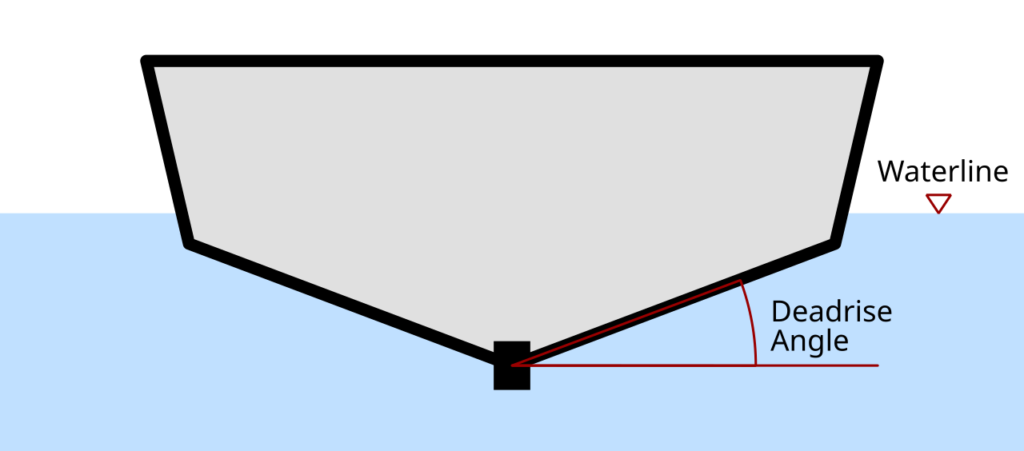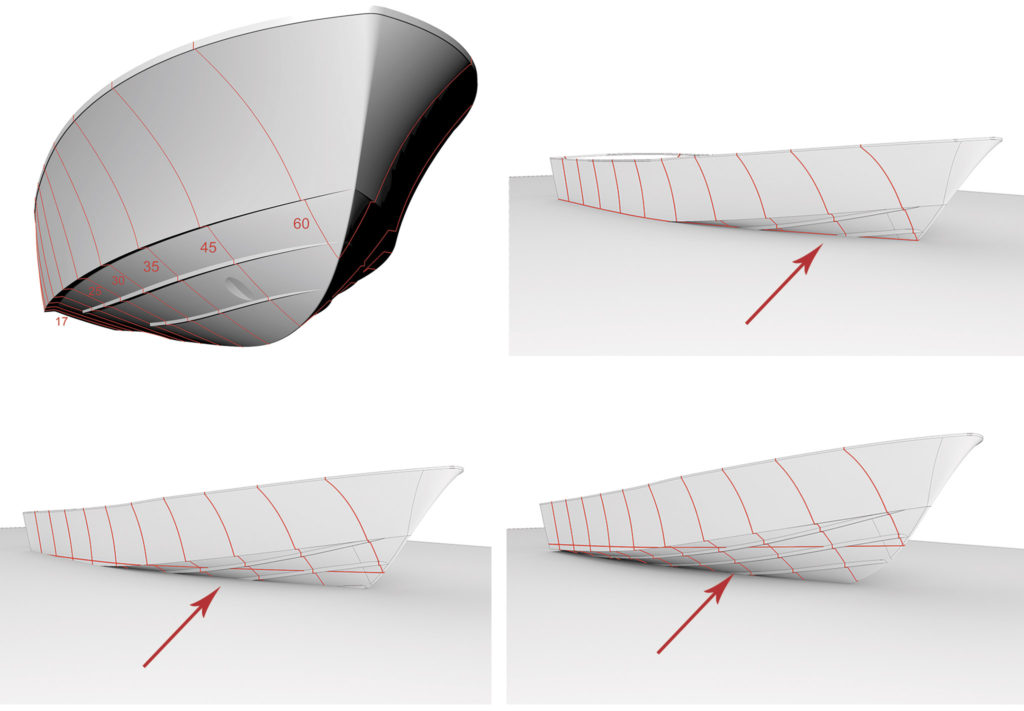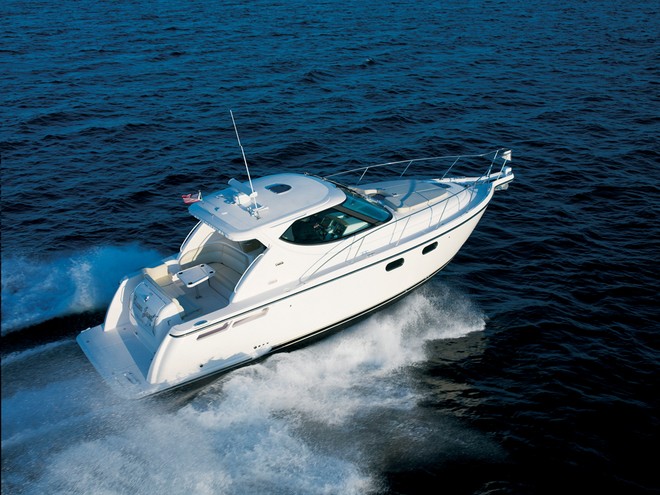If you’ve ever researched boats, especially powerboats, you’ve likely come across the term deadrise. It’s often mentioned in specs or marketing materials, but what does it actually mean? More importantly, why should you care when choosing a boat?
The Basics: What Is Deadrise?
Deadrise refers to the angle between the bottom of the hull and a horizontal plane, measured from the keel toward the chines. In simpler terms, it’s how much the hull “V”s as it moves away from the centerline.
Unless you’re dealing with a flat-bottomed barge, deadrise varies along the length of a boat. The bow typically has a steeper deadrise than the stern because it’s the first part of the hull to cut through waves. This variation affects how a boat rides, handles, and performs at different speeds and sea conditions.

How Deadrise Affects Ride & Performance
At low speeds (under 8 knots), the hull is in displacement mode, pushing through the water rather than climbing on top of it. In this state, the entire hull sits at the same level as when it’s at rest, meaning waves hit the bow directly. That’s why boats with deeper deadrise forward tend to ride smoother in chop— they slice through waves instead of pounding against them.
Once a boat gets on a plane—typically above 15 knots—it rises out of the water, relying on lift to stay afloat rather than just buoyancy. The shape of the hull at this stage is crucial, and faster hulls will need more deadrise farther aft and in the middle of the hull. However, too much deadrise aft will make it difficult for the boat to get on a plane efficiently, leading to sluggish acceleration and excessive fuel burn. Too little deadrise aft, and the boat may handle poorly in rough conditions, making it harder to stay on course, especially when running with following seas.
Variable Deadrise: Finding the Right Balance
Most boats have variable deadrise, meaning the angle changes from bow to stern. This design allows for the best of both worlds—enough deadrise forward for a smooth ride and less deadrise aft for stability and efficiency.
For example, a high-performance offshore boat like a Tiara or Sea Ray might have around 21-24 degrees of deadrise at the transom. This helps them maintain speed and control when running offshore. On the other hand, fishing boats like Grady-White tend to have slightly less transom deadrise (18-20 degrees), giving them a stable platform for angling while still handling waves well.

Trawlers and cruising yachts, such as Grand Banks, DeFever, and Hatteras, are designed differently. Their hulls are more rounded or feature deep keels, meaning deadrise isn’t as crucial for handling. Instead, they prioritize stability at displacement speeds over the ability to plane.
| Boat Model | Length (ft) | Deadrise Angle (degrees) |
|---|---|---|
| Grady-White 216 | 21’6″ | 20° |
| Regal 2500 Bowrider | 26’3″ | 21° |
| Albin 28 Tournament Express | 29’11” | 16° |
| Grady-White 285 Freedom | 28′ | 19° |
| Monterey 280 Sport Cruiser (280SC) | 29′ | 17° |
| Jeanneau NC 895 (formerly Jeanneau 29) | 29’3″ | 15° |
| Ocean Master 31 | 31′ | 24° |
| Sea Ray 310 Sundancer | 31’6″ | 21° |
| Sea Ray 320 Sundancer | 32’3″ | 21° |
| Back Cove 34 | 38′ | 16° |
| Sea Ray 340 Sundancer | 34’6″ | 21° |
| Tiara 3500 | 35’9″ | 18° |
| Beneteau Gran Turismo 38 (38 GT) | 37’9″ | 16° |
| Tiara 3900 Sovran | 39’3″ | 17° |
| Monterey 400 Sport Yacht (Monterey 40) | 41’8″ | 18° |
| Bertram 42 Convertible | 42′ | 17.5° |
| Sea Ray 44 Sundancer | 45’6″ | 19° |
Why It All Matters
Understanding deadrise can help you choose the right boat for your needs. If you primarily use your boat offshore and often see rough conditions, a deeper deadrise hull will be a worthwhile investment. If stability at rest or fuel efficiency is more important, a shallower deadrise may be a better fit.
A well-designed hull balances deadrise with other factors like weight distribution, chine design, and trim. The right combination ensures a boat that’s comfortable, efficient, and easy to handle in a variety of conditions.
When looking at a boat’s specs, don’t just focus on speed or length—deadrise plays a big role in how enjoyable your time on the water will be. Whether you’re chasing fish, cruising with family, or heading offshore, knowing what deadrise means can help you make a smarter decision.
Have questions about which hull design is right for your boating needs? Let’s talk!
Deadrise refers to the angle between the bottom of the hull and a horizontal plane, measured from the keel toward the chines. In simpler terms, it’s how much the hull “V”s as it moves away from the centerline. The bow typically has a steeper deadrise than the stern because it’s the first part of the hull to cut through waves. This variation affects how a boat rides, handles, and performs at different speeds and sea conditions.
A well-designed hull balances deadrise with other factors like weight distribution, chine design, and trim. The right combination ensures a boat that’s comfortable, efficient, and easy to handle in a variety of conditions. A high-performance offshore boat like a Tiara or Sea Ray might have around 21-24 degrees of deadrise at the transom. This helps them maintain speed and control when running offshore.

